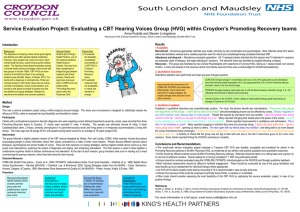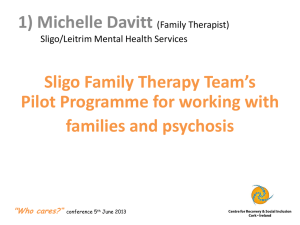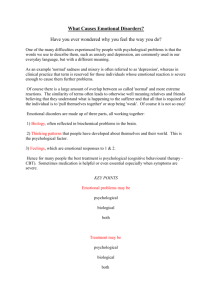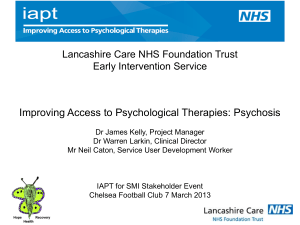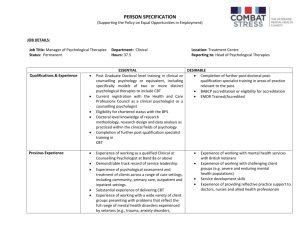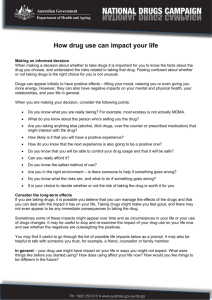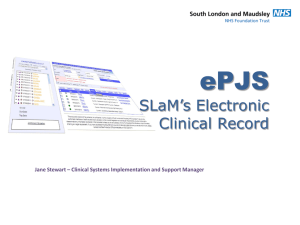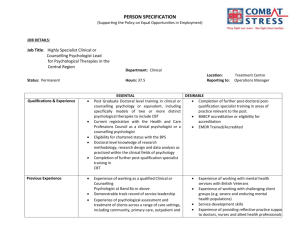Document
advertisement
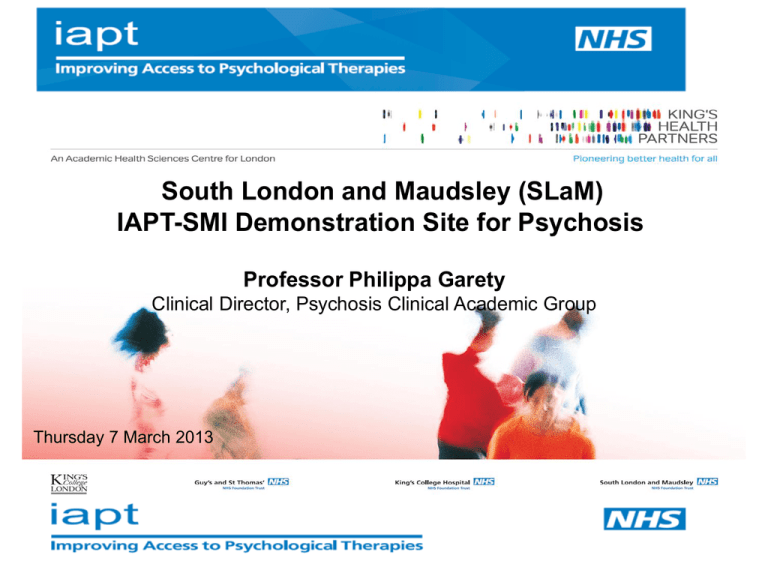
South London and Maudsley (SLaM) IAPT-SMI Demonstration Site for Psychosis Professor Philippa Garety Clinical Director, Psychosis Clinical Academic Group Thursday 7 March 2013 Service users want equal access to psychological therapies Rethink survey (2010) Research suggests that only 1 in 10 access CBT, despite NICE guidance (Schizophrenia Commission, 2012) The Abandoned Illness The Schizophrenia Commission “Research has led to a range of evidence-based psychological treatments. We know much more about ‘what works’ than we used to. . . The committed individuals who went into the mental health profession to improve lives should be helped to do exactly that.” Prof Sir Robin Murray This is where IAPT-SMI comes in Obstacles to access Dolly Sen, Service User Consultant “I always asked for some kind of psychological therapy or talking therapy but was told, no, it was too dangerous. I had to wait 20 years for something that was the most beneficial thing. [Therapy] has changed my life basically.” Talking to Norman Lamb on 19 December 2012 69% of Trusts have funding challenges for providing access to psychological therapies for people with a diagnosis of schizophrenia 94% have encountered obstacles in making psychological therapies available, including insufficient skilled staff Delays in accessing CBTp Peters et al 2009 (N=74) • Mean length of illness was 8 years (range 0-32) • Mean of 2.8 in-patient admissions (range 0-20) • 96% were on antipsychotic medication South London and Maudlsey NHS Foundation Trust: the context • Core population - 4 South London Boroughs 1.3million; inner city, very high indices of social deprivation • Substantially raised rates of psychosis • Psychosis Care Pathways SLaM Psychosis Demonstration site: Increasing access in two care pathways IAPT-EI Early Intervention Pathway (Southwark, Lambeth, Croydon & Lewisham) IAPTPICuP IAPTSHARP Promoting Recovery Pathway (Lambeth) Promoting Recovery Pathway (Southwark, Croydon & Lewisham) SHARP What IAPT-SMI offers for service users CBT for psychosis: • weekly or fortnightly individual 1 hour sessions • 6-9 months therapy • Therapists receive weekly-fortnightly group supervision FI for psychosis: • • • • Fortnightly 1 hour sessions with client and carer(s) Up to ten sessions, over a period of 3-9 months Therapy delivered by two trained therapists Therapists receive weekly-fortnightly group supervision Overcoming obstacles to access Work we have already done in SLaM • Ten point charter addressing barriers and facilitators: – Service user involvement – Quality criteria and staff training – Data gathering, data systems and outcomes – Care pathways, ensuring integrated effective care in Early Intervention & Recovery pathways Psychological treatments are not a quasi - medication = Quality • One key challenge has been a lack of clarity about quality – psychological therapy is different from a chemical compound • Lack of criteria have resulted in an ‘anything goes’ approach to psychological therapy in MH services, and inflated estimates of provision • We need nationally agreed criteria for training and competencies in CBTp and FI • IAPT-SMI is doing this • Locally we have already developed criteria and standards and established a portfolio of training opportunities Training and Supervision Training and Supervision • Portfolio of training opportunities in psychological therapies for psychosis, in partnership with KCL • Span the workforce from non-clinical to managerial/supervisory • Academically accredited training and in-service courses • Short courses and modules build to an award • Supervised practice strongly emphasised • Supervision and support for supervisors Training structure in the SLaM site Service user and caregiver involvement & co-production • Involvement in development, design and evaluation of psychological therapy services • Training design and delivery • Co-produced workshops at SHARP and in the SLaM Recovery college • Co-working in group interventions: Hearing Voices; Mindfulness; Acceptance & Commitment Therapy • Training, supervision and support (practical, financial and emotional) • Personal development – CPD, co-authorship, conference attendance SLaM demonstration site strategic approach to improving access to therapy • A 50% increase in access with the funding provided • Reduced waiting times • Implementation of our 10 Point Charter, with highly trained staff, and care pathways • Clear referral pathways, including self referral • Regular assessment of progress in therapy • Close and frequent supervision • Assessing improvement in a range of outcomes and in health economics Effectiveness Clinical outcomes: Service-user reported symptoms Evidence of clinical outcomes with medium-large effect sizes – voices and delusions 89% (voices) & 90% (delusions) have paired data at end of therapy 30 16 Voices Delusions 25 Voices 12 10 20 Delusions 14 8 15 6 Assessment (N=96, 125) Before therapy (N=70, End of therapy (N=85, 80) 113) This graph shows a reduction in psychotic symptoms [voices (effect size: .73) and delusions (effect size: .59)] following therapy (PICuP) Evidence of clinical outcomes with mediumlarge effect sizes – anxiety and depression 85% have paired data at end of therapy 24 26 22 22 20 20 18 Anxiety Depression 24 Depression Anxiety 18 16 16 14 14 Assessment (N=176) Before therapy (118) End of therapy (148, 152) This graph shows a reduction in emotional problems [anxiety (effect size: .47) and depression (effect size: .55)] following therapy PICuP Evidence of clinical outcomes with mediumlarge effect sizes – quality of life (QoL) and recovery 85% (QoL) & 67% (CHOICE) have paired data at end of therapy 54 140 130 52 50 110 48 CHOICE MANSA 120 QoL Recovery 100 46 90 44 80 Before therapy (174; 113) End of therapy (131, 76) This graph shows an increase in people’s quality of life (measured on the Manchester Short Assessment of Quality of Life; effect size: .51) and recovery ratings (measured on the CHOICE; effect size .79) following therapy Cost-effectiveness Mean 9-month cost (2005/6 £s) Randomised Controlled Trial (Peters et al, 2010) – therapy costs are off-set by fewer inpatient costs at 3 months follow-up Therapy Inpatient care Non-inpatient care 14000 £12,558 12000 (N = 74) 10000 £9018 8000 £6602 £7236 6000 4000 2000 0 Therapy (baseline) Control (baseline) Therapy (follow-up) Control (follow-up) Reduction in service-use costs (admissions & home treatment team days) in the year following therapy, compared to the year prior to therapy (Wilcoxon test: p <.05*) Costs per month (£) 500 451.46 Data obtained from ePJS, Jan 2012 400 N = 70 300 172.24 200 100 0 1 year prior to therapy 1 year following therapy Progress and preliminary outcomes New clients - demographics Variable New clients in the service Age distribution Mean 38 years (18-70) Gender 43% male, 57% female Ethnicity 36% white, 64% BME Demonstration site CBTp & FIp referral targets are being achieved Existing Projection Monthly Referral Target (over 12m) Progress at 4 months CBT FI CBT FI CBT FI CBT FI 106 15 50 10 14 2-3 95 11 Waiting times are reduced (in days) Referral received to opted-in Opted-in to assessed Assessed to receiving therapy 35 7 23 Total 57 % reduction in waiting times 60% Health Utilisation data Service Mental health admission Mean number of days in 12m before therapy 10.5 (0-126) Crisis team / home treatment 0.7 (0-23) Psychiatric liaison (A&E) 0.1 (0-2) IAPT-SMI: CBT assessments Pre 3-monthly Post PSYRATS – Voices & Beliefs PSYRATS – Voices & Beliefs PSYRATS – Voices & Beliefs WEMWBS WEMWBS WEMWBS WSAS WSAS WSAS EQ-5D EQ-5D EQ-5D Short CHOICE Short CHOICE Short CHOICE CORE-10 CORE-10 CORE-10 Brief IPQ Brief IPQ Brief IPQ Measures Feedback Measures Feedback Measures Feedback Satisfaction with therapy Satisfaction with therapy Short CHOICE weekly IAPT-SMI: Carer assessments Pre 3-monthly Post Experience of caregiving inventory Experience of caregiving inventory Experience of caregiving inventory WEMWBS WEMWBS WEMWBS DASS-21 DASS-21 DASS-21 CORE-10 CORE-10 CORE-10 IPQ carer version IPQ carer version IPQ carer version Confidant question Confidant question Confidant question Measures Feedback Measures Feedback Measures Feedback Satisfaction with therapy Satisfaction with therapy Patient Reported Outcome Measures Measure Session by session short CHOICE Pre-therapy: PSYRATS Questionnaires Completion rate 81% of attended sessions 98% 100% London Tonight report from 19 December 2012 – visit to SLaM by Norman Lamb, Care and Support Minister and the official launch of the IAPT-SMI demonstration sites: http://www.itv.com/news/london/update/2012-1220/maudsley-hospital-pioneers-mental-healththerapy-scheme/ Operational Group Dr Louise Johns, Project Lead Dr Miriam Fornells-Ambrojo, IAPT-EI Lead Dr Suzanne Jolley, Lambeth Recovery Psychology Lead Rosanna Michalczuk Bina Sharma Psychology Assistants Dr Craig Milosh, Clinical Psychologist, SHARP Devon Elliott, Business Intelligence Analyst Dr Juliana Onwumere, FI Lead Steering Group • • • • • • • • • • • • • • • Lucy Canning, Psychosis CAG Service Director Prof Philippa Garety, Psychosis CAG Clinical Director Jonathan Beder, Psychosis CAG Deputy Director, Business and Performance Dolly Sen and Garry Ellison, Service User consultants Roger Oliver and Lorna Wilkinson, Carer consultants Prof Tom Craig, Consultant Psychiatrist, SHARP Marieke Wrigley, Team Leader, SHARP Prof Elizabeth Kuipers, NICE Schizophrenia guideline lead Dr Emmanuelle Peters, PICuP Director Adrian Webster, CAG Psychological Therapies Lead Jo Lawrence, Clinical Service Lead, EI Dr Sarah Dilks, Lead Psychologist, Promoting Recovery pathway Dr Eric Morris, Lead Psychologist, Early Intervention pathway Penelope Fell, Head of Business Development Dorothy Abrahams, Administrator Thank you for listening! You are welcome to our SLaM Demonstration Site Visit Monday 1 July 2013 1.00-5.00 pm Louise.johns@slam.nhs.uk
